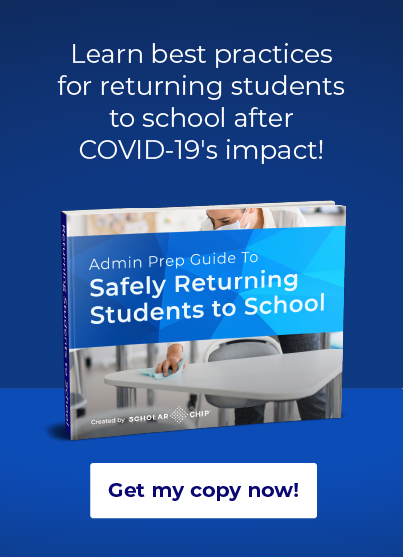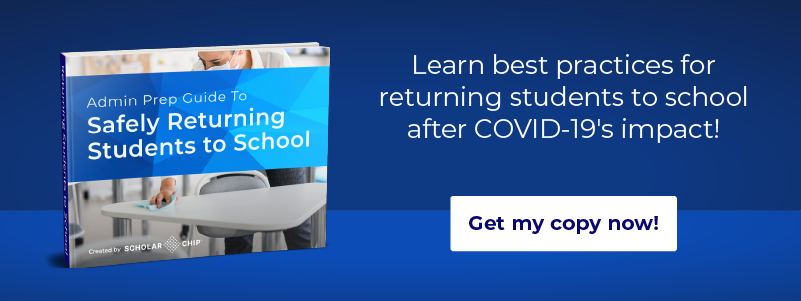As the summer season continues and experts predict a second wave of COVID-19 in the fall, administrators must consider their options when it’s time to reopen schools. What factors should you consider when you plan to reopen schools after COVID-19?
Many national and international organizations like the Centers for Disease Control and Prevention (CDC) and the World Health Organization (WHO) have provided guidelines for reopening for administrators. Here, we’ll answer a few of the most important questions that will guide your reopening.
At what level of risk am I willing to operate?
The CDC offers guidelines for a variety of COVID-19 risk levels based on several factors:
- Lowest risk. Schools are virtual only. Everything from classes to extracurricular activities takes place online.
- More risk. There are smaller in-person activities, with classes staying with the same teacher all day and students remaining separate. This school setup may include a hybrid of virtual and face-to-face courses, as well as staggered schedules. Students should stay 6 feet apart at all times and avoid sharing items.
- Highest risk. Schools operate the same way as they did before the pandemic. Classes are the same size as they were pre-pandemic, and students don’t practice social distances. Groups of students mix as they move from class to class.
How can I limit the risk of COVID-19 transmission when districts reopen schools?
Many of the same techniques that you’ve been using to limit disease transmission in your own home are the same that need to happen in the school environment. A few of the WHO’s recommendations:
- Create handwashing stations and provide sanitation supplies. Students and staff need to be cleaning their hands often. That means that soap-and-water handwashing stations should be plentiful, and sanitizer should be placed near campus and classroom entrances, exits, bathrooms, and lunchrooms.
- Cancel events that draw crowds. A critical recommendation is to continue social distancing on physical campus spaces. The larger the group, the harder it is to social distance responsibly. That means canceling large crowd events, like assemblies, sports matches, and theatrical performances, where attendees can’t stay 6 feet apart.
- Communicate with stakeholders. Students, faculty, staff, and parents need to work together to ensure that schools can safely reopen after COVID-19. This means that everyone needs to communicate effectively about the importance of sanitation and social distancing policies. For instance, teachers should model appropriate habits for their students. School campaigns should answer any questions that students have about why they need to make these changes.
I’ve heard that smaller classes and staggered class times can prevent transmission. How can I make this happen at my school?
It can be daunting to follow the CDC’s recommendations for having in-person school. Students need to stay in the same class groupings throughout the day, so they don’t have exposure to other students, including passing each other in the hallways. There should also be shorter school days.
This sounds a logistical nightmare to many administrators. But with ScholarChip’s One Card and Secure Door Access, it doesn’t have to be.
At the start of the school year, every student should be given a One Card. The ID card has a chip embedded with the student’s unique ID number. This unique identifier lets you keep track of the student as they move around campus.
Whenever the student enters a classroom, they’ll tap their ID card on the reader mounted outside the door. This lets you know how many students are attending each class. When a student leaves campus for the day, they will tap out, giving you a clear indication of how many students are on campus at any given time.
I want to create a moderate-risk environment when we reopen schools, but I still want students and teachers to be able to interact online. What systems can I use to track their interactions?
One of the worries that administrators, staff, and faculty have about online learning is that students will no longer be held accountable. In a similar vein, students may feel like they’re slipping through the cracks.
Certainly, students who learn completely or nearly-completely virtually can face various struggles. The New York Times reports that students—especially those in low-income schools—had increased absenteeism in the first semester of online learning during the pandemic. Further, students may face other behavioral or progress-based issues that instructors may feel ill-equipped to confront.
However, ScholarChip’s Alternative Behavior Educator (ABE) is particularly useful in online settings. ABE works by letting teachers and staff recommend specific behavior changes for students struggling with certain expectations. The tool will share behavior modifications with students in fun, easy-to-understand modules. This way, teachers feel like they have a scaffolding for student behavior issues without having to create interventions themselves.
When your school is preparing to reopen after COVID-19, it’s essential to stay up to date with new updates from local, state, and national organizations. As the conditions of the pandemic shift, you’ll need to be flexible in updating your plans for reopening in August or September. At the same time, you want to make sure that your plans will prepare your students for effective future learning.


